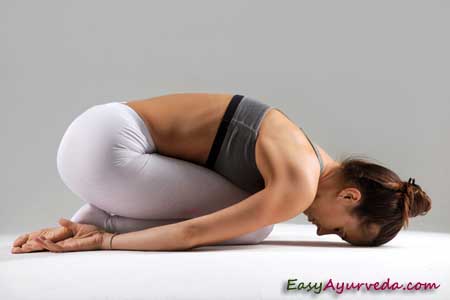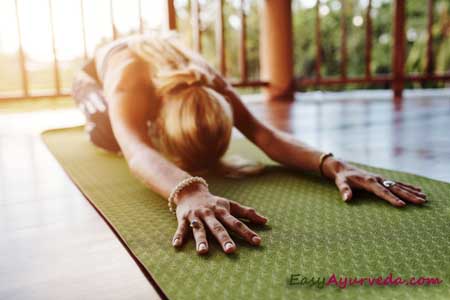Balasana – Child’s Pose Method, Benefits, Side Effects, Ayurveda View
Article by Dr Raghuram Y.S. MD (Ay) & Dr Manasa, B.A.M.S
Balasana is an asana in which the performer of the asana assumes the shape of a ‘child in resting pose’ or resembling the child in ‘fetal position’. Therefore it is called as Balasana or Resting Child’s Pose.
It is a resting pose which focuses on the thighs and helps in providing relief from back pain. It is performed with a complete gravitational pull and the doer experiences a great sense of physical, mental and emotional solace after having performed the Balasana.

Table of Contents
Word meaning
Balasana or Child’s (Fetal) Pose or Child’s Resting Pose
Meaning –
Bala = Child, Fetus
Asana = Pose, Posture
Preparation for Balasana
- Balasana should be practiced preferably in the morning time, but as an exception it can be practiced during evening or any convenient time. It can be practiced whenever you need to relax, in between your work schedules or workouts also. Since it is a resting pose, it is convenient to do.
- The stomach, bowel and bladder should be kept clean and empty before practicing or commencing this asana.
- If you are planning to do it after consuming food, make sure to take your food 4-6 hours prior to commencement of this asana. In the given time gap, the food gets easily digested and also provides good energy. By the time you commence Balasana, the stomach would have been naturally empty.
Method
Method of doing Balasana
Positioning for the Asana
- To begin with, kneel on the floor or Yoga Mat.
- As you gradually sit on your heels bring your big toes (of both foot) close to each other such that they touch each other.
- After making yourself comfortable, slowly spread your knees hip-width apart.
- Now inhale slowly.
Performing and getting to the Balasana
- Slowly bend forward such that your torso is brought in between the thighs. Lay your torso between your thighs as you gradually exhale.
- Gradually broaden the lower part of your spine (sacrum) all across the back of the pelvis.
- Narrow the points of your hips such that they point towards the navel.
- Slowly settle down on your inner thighs.
- Stretch your tailbone (coccyx) away from the back of the pelvis.
- At the same time, lift the base of your head slightly away from the back of the neck.
- Stretch your upper limbs (arms) forward.
- Place your arms in front of you, stretched on the floor. See that your arms are in line with your knees.
- Gradually release the front of your shoulders to the floor.
- While doing this, you should feel the weight of the front of your shoulders pulling your shoulder blades widely across your back.
- Stay in this asana or pose for a time ranging between 30 seconds to a few minutes or for whatever time you are comfortable in that pose.
Release from the asana and coming back to the point of start
- After keeping yourself positioned in this asana for few seconds to few minutes, gradually release yourself from this position.
- Stretch the front portion of your torso and gradually lift it from in between the thighs while gradually lifting your arms off the floor.
- Breathe in slowly.
- As you breathe in, lift from the tailbone while it pushes down into the pelvis.
- Gradually come to the point of start and relax.

Advanced pose
Advanced pose or pose alterations (variation of Balasana)
As an alteration in the asana, you can place your hands beside your body, alongside your torso (rather than keeping them stretched in front of your torso in traditional Balasana), with your palms facing upwards. This variation will give you more relaxation.
Purva Asanas
Purva Asanas (Preparatory Asanas)
Before Balasana one can do Virasana or Hero’s pose as a preparatory pose and gradually proceed to do the Balasana.
Paschat Asanas
Paschat Asanas (Post-Balasana Poses)
Balasana is basically a resting pose. Any asana can be performed before or after performing Balasana.
Duration
What time should be spent in the pose while doing Balasana?
Balasana can be done for 1 to 3 minutes at a stretch. The time can be extended depending on one’s comfort zone or as long as one feels comfortable in being in this pose.
Health benefits
Health Benefits of Balasana
Below mentioned are the benefits of Balasana –
- Balasana gives good stretch to the hip, ankles and thigh
- It properly stretches the tendons, muscles and ligaments around the knee joints, makes the knee joints flexible and improves movements therein
- The asana strengthens the neck, shoulders and back
- Releases the tension in the shoulders, chest and back and relaxes them
- It helps to lengthen the spine apart from giving it a good stretch and relaxing it.
- It relieves low back pain and neck pain.
- It instantly relieves the bouts of dizziness or feel of fatigue occurring during your work schedules, when you practice Balasana amidst your workouts, during any part of the day.
- Balasana is a good reliever of stress and anxiety.
- It gives a good massage to the organs of the body and makes them flexible and active.
- It promotes blood circulation and makes the blood and oxygen and nutrients available at each corner of the body.
- Balasana puts us in the right way of breathing or enables us to breathe properly. In the process it helps calm both the body and mind.
Effect on Doshas
Effect of Balasana on Doshas and Subtypes
Balasana calms the mind and helps in relieving stress and anxiety. It also relieves fatigue and dizziness. This is possible because Balasana balances and calms Prana Vayu, Udana Vayu and Tarpaka Kapha.
Balasana helps in promoting circulation of blood, oxygen and nutrition to all corners of the body. This happens due to the balancing role of Balasana on Vyana Vayu. The asana also brings about a good sync between Vyana Vayu, Prana Vayu, Avalambaka Kapha and Ranjaka Pitta, which is very essential for the circulation to take place uninterruptedly.
Balasana sets right the breathing patterns. Therefore it promotes synchronization and coordination between Prana Vayu, Udana Vayu and Avalambaka Kapha.
Effect on Dhatus
Effect of Balasana on Dhatus – tissues:
Balasana strengthens Mamsa Dhatu (muscle tissue) and Asthi Dhatu (Bone Tissue). It gives a good stretch and strengthens the mamsa dhatu, snayus (ligaments) and kandaras (tendons). By doing so, it stretches and strengthens the spine, neck, back, joints of lower limbs and shoulders.
Balasana, what it promises!
Balasana or Resting Child’s Pose or Fetal Pose can be performed at any point or time, when you are free and also amidst your work schedules. It is a resting pose and provides best relaxation to the body and mind along with curing many diseases.
Balasana is a resting, calming and restorative pose. It relaxes and rejuvenates the body and mind and in no time you will feel at the top of your energy levels. It provides good stretch to your back and relaxes your spine and nerves. It helps in calming and relaxing the muscles of the limbs and back. Thus it helps to alleviate pain in the neck, shoulders and back. It also provides a good stretch to the knee joints, the muscles and soft tissues surrounding the knee joints. It relieves stiffness in the knee joints, relaxes the joints, and makes them fit, flexible and functioning.
The child is happy, relaxed and at bliss when in the fetal stage, in the mother’s womb. The Balasana or fetal pose provides a similar feel due to its resemblance with the fetus or resting child. It provides utmost physical, mental and emotional bliss, comfort and solace when performed on regular basis.
The child’s pose promotes positive vibes and feelings in the doer and transports him or her to the golden days of childhood. It strips off your ill feelings and arrogance and helps you to be an innocent kind from the interior, good to yourself and good to others.
Impact on Chakras
Balasana is said to activate Swadishtana Chakra and helps one to draw the vitalizing energy down from the Earth, into the body. If Balasana is skillfully blended with Prana Mudra, it helps in eliciting the life force within us and also activates the Swadishtana Chakra. It is also said to stimulate the third eye chakra and provide mindfulness while encouraging introspection and contemplation.
Balasana balances Vishuddha Chakra which helps us in communication and self expression, to express our choices and voice. By activating the Anahata or Heart Chakra, Balasana helps in a balanced circulation.
Contraindications and precautions
Who should not do? (Contraindications and precautions for doing Balasana)
Patients suffering from below mentioned conditions should avoid doing Balasana –
- Diarrhea
- Knee injuries
- Severe neck or back pain
- High blood pressure
- Vertigo
- Slipped disc
If you find it difficult or uncomfortable to place your head on the floor, you need to take caution. You can use a pillow for comfort and proceed to do the asana.
Just Before Finish
Balasana while being a resting pose bestows extremely good benefits on health, gives stretches to the joints, muscles and soft tissues and keeps the child in you happy and healthy.
Click to Consult Dr Raghuram Y.S. MD (Ayu) – Email / Skype









